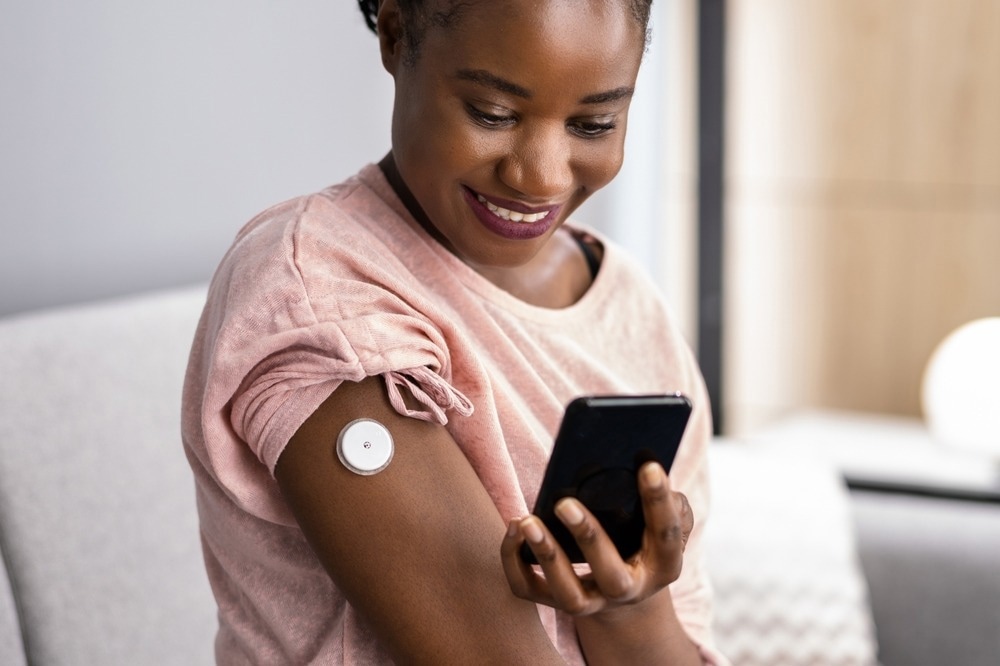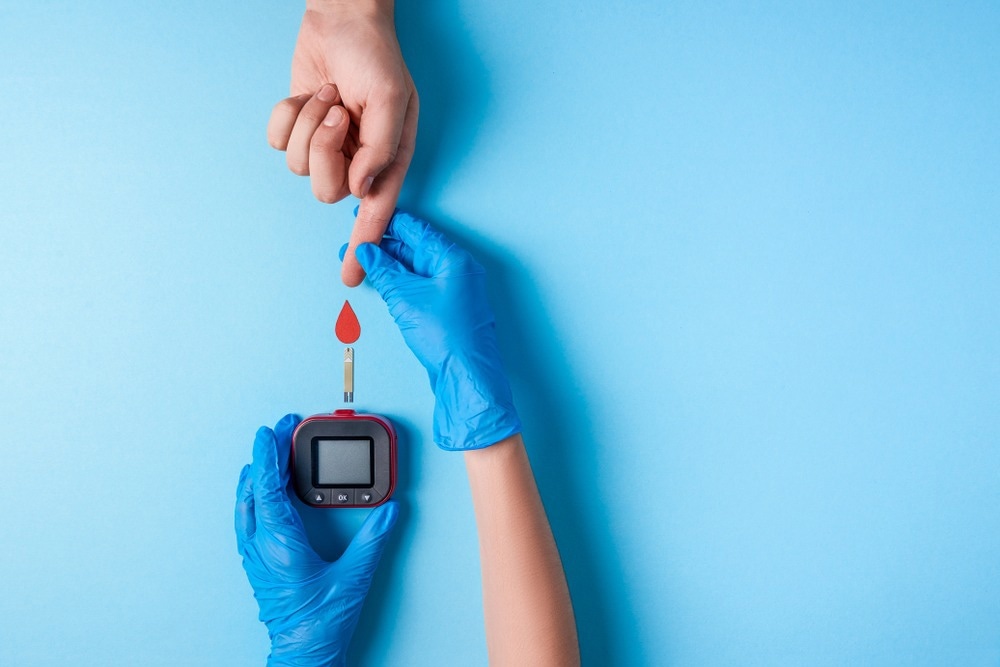Glucose monitoring is critical for managing chronic illnesses such as diabetes, which affects millions of people across the world. Traditionally, measuring glucose levels has proven invasive, requiring multiple blood samples and finger pricks. Here, we explore how nanosensors are revolutionizing glucose monitoring.

Image Credit: Andrey_Popov/Shutterstock.com
Introduction to Glucose Monitoring
Blood glucose monitoring can help identify shifts in the variation of glucose (sugar) levels caused by diet, physical activity, medicines, and pathological processes, such as diabetes mellitus.
Glucose monitoring requires invasive procedures such as finger pricks to collect blood samples for analysis.
Nanosensors, which usually measure in nanometers, provide a highly accurate and noninvasive method of determining the body's glucose levels. They often detect changes in optical, chemical, or electrical properties in response to changes in glucose concentrations.
Nanosensors can detect glucose levels in physiological fluids such tears, saliva, and interstitial fluid with high precision and rapidity, thus rendering them suitable for glucose monitoring and eliminating the need for regular blood draws.
Nanosensors vs. Traditional Monitoring Methods
Conventional blood glucose monitoring involves fingertip pricking, in which individuals must try to keep their glucose levels within 4.4 and 6.7 mm/L.
Glucose meters or biosensors are typically used to aid this. However, this strategy has the possibility of neglecting hyperglycemic and hypoglycemic fluctuations between sample points, as well as reducing predictive power.
Finger-pricking blood tests can produce incorrect findings at times due to faulty blood sample, and they can also induce infections due to the invasive nature of the procedures. As a result, continuous glucose monitoring is essential for illness detection, treatment, and control.
The adoption of nanosensors for glucose monitoring provides various benefits over conventional approaches. They provide the ability to analyze glucose levels through bio-fluids such as skin and sweat, allowing for continuous, real-time monitoring via a minimally invasive or noninvasive approach.
Nanosensors can provide precise glucose detection results. The glucose oxidase test is used by most glucose nanosensors to measure blood glucose electrically or chemically.
These sensors also improve the surface-to-volume ratio and feature greater detecting capabilities, including high sensitivity and accuracy. They also require a smaller sample amount for the detection of glucose levels.
Applications and Benefits of Nanosensors in Glucose Monitoring
Researchers have discovered several methods to build glucose nanosensors that can precisely detect and rapidly monitor glucose levels using various transducers such as frequency, chemiluminescence, optical fluorescence, and electric signals.
The applications of nanosensors in glucose monitoring are diverse and far-reaching.
Tissue-Translatable Glucose Nanosensors
Investigators have developed near-infrared fluorescent nanosensors employing single-walled carbon nanotubes (SWCNTs) modified with glucose oxidase (GOx) for noninvasive and continuous glucose monitoring.
They successfully created GOx-SWCNT nanosensors using a simple sonication approach, and they were surprised to discover that this method does not impair GOx's capacity to detect glucose.
Notably, they reported that the fluorescence modulation of these nanosensors is governed by glucose binding to GOx rather than catalytic oxidation.
Building on this distinct response mechanism, the researchers created catalytically inert apo-GOx-SWCNT sensors.
These sensors are highly sensitive and reversible in glucose imaging, achieving a considerable fluorescence change (ΔF/F0) of up to 40% in just one second of exposure without consuming the analyte.
The researchers proved the potential biomedical utilization of apo-GOx-SWCNT sensors by effectively measuring glucose within human plasma and visualizing glucose in mouse brain slices.
These findings highlight the technology's great potential to revolutionize glucose monitoring in a variety of clinical and research settings.

Image Credit: Kateryna Novikova/Shutterstock.com
Detection of Glucose via pH or Charge Change
Nanomaterial-based sensors, such as field effect transistors (FETs), can recognize glucose via pH or charge changes. These devices assess nanomaterial characteristics as influenced by charges near the sensor's surface or the solvent's pH.
The gluconate ion is produced when glucose oxidase (GOx) breaks down glucose, lowering the pH of the solution while generating negative charges.
Risveden and colleagues used a region-selective ion-sensitive field-effect transistor (RISFET) to monitor gluconate production and quantify glucose concentrations.
The RISFET concentrates the gluconate among sensing electrodes, increasing the current proportionally to the glucose concentration.
The layer-by-layer construction of carbon nanotubes (CNTs) with GOx enables the monitoring of pH variations caused by glucose breakdown, as measured by conductance variations in the CNT layer.
Wearables for Glucose Monitoring
Wearable technologies, such as wristbands or headbands, which offer noninvasive monitoring, can significantly enhance glucose monitoring.
Researchers have created a thin, flexible, waterproof film sensor to enable the detection and monitoring of glucose concentrations in sweat using a wrist-mounted device.
The sensor detects glucose using graphene-doped gold (Au) nanoparticles and a Nafion fluoropolymer patch, producing a highly robust electrochemical signal.
Furthermore, this patch may perform two functions: detecting glucose levels in sweat samples and enabling a precise supply of insulin for diabetes control via a touchable skin patch.
Implantable Nanosensors for Glucose Monitoring
Investigators proposed a subcutaneously implanted electromagnetic-based sensor to monitor the smallest variations in blood glucose levels. Validation using intravenous glucose tolerance test (IVGTT) on pigs and beagles indicated potential.
They created mobile apps, interface modules, and algorithms to enable continuous measurement during oral glucose tolerance tests (OGTT) in freely roaming beagles. Both short-term and long-term experiments on animal species revealed a strong association between sensor frequency and glucose levels.
Future Trends in Nanosensor Technologies for Glucose Monitoring
The application area of nanosensor technology is quickly evolving, with continuous research and development initiatives focused on glucose monitoring.
Over the last decade, artificial intelligence has emerged in an attempt to improve the efficacy of glucose sensors. The combination of nanosensors and artificial intelligence (AI) algorithms has tremendous potential for improving glucose data analysis and interpretation, allowing individualized treatment recommendations and predictive modeling to anticipate glucose variations and avert issues.
Feng et al. developed a unique strategy for detecting glucose levels that combines colorimetry with deep machine learning and uses a convolutional neural network (CNN). They employ a plasmonic nanosensor that contains Au nanoparticles and copper oxide (Cu2O) to cause color variations.
The CNN is trained to detect small color fluctuations that are invisible to human sight, resulting in great accuracy and robustness to environmental influences.
This method is deployed as an application for smartphones and successfully evaluated on clinical specimens of urine, showing a promising correlation to routine blood glucose assays.
As nanosensor technology research and development progresses, the future holds enormous promise for discoveries that will enhance glucose monitoring and pave the path for customized healthcare.
References and Further Reading
Cash, K.J., & Clark, H.A. (2010). Nanosensors and nanomaterials for monitoring glucose in diabetes. Trends in Molecular Medicine, 16(12). p. 584. doi.org/10.1016/j.molmed.2010.08.002
Battery-Independent Fluorescent Nanosensor for Glucose Monitoring. Available at: https://www.azonano.com/news.aspx?newsID=40610. (Accessed February 12, 2024).
Nishitani, S., et al. (2023). Engineered Glucose Oxidase-Carbon Nanotube Conjugates for Tissue-Translatable Glucose Nanosensors. Angewandte Chemie International Edition. doi.org/10.1002/anie.202311476
Mathew, T.K., (2023). Blood Glucose Monitoring. Medical Devices and Systems. April 2023:66-1-66-10. doi.org/10.5005/jp/books/12651_10
Johnston, L., et al. (2021). Advances in Biosensors for Continuous Glucose Monitoring Towards Wearables. Frontiers in Bioengineering and Biotechnology. 9, p. 733810. doi.org/10.3389/FBIOE.2021.733810/BIBTEX
Safarkhani, M., et al. (2023). Nanomaterial-assisted wearable glucose biosensors for noninvasive real-time monitoring: Pioneering point-of-care and beyond. Nano Materials Science. doi.org/10.1016/j.nanoms.2023.11.009
Feng, F., et al. (2023). Artificial intelligence-assisted colorimetry for urine glucose detection towards enhanced sensitivity, accuracy, resolution, and anti-illuminating capability. Nano Research. 16(10), pp. 12084-12091. doi.org/10.1007/S12274-022-5311-5/METRICS
Kim, S., et al. (2022). Subcutaneously implantable electromagnetic biosensor system for continuous glucose monitoring. Scientific Reports, 12(1). doi.org/10.1038/s41598-022-22128-w
Disclaimer: The views expressed here are those of the author expressed in their private capacity and do not necessarily represent the views of AZoM.com Limited T/A AZoNetwork the owner and operator of this website. This disclaimer forms part of the Terms and conditions of use of this website.